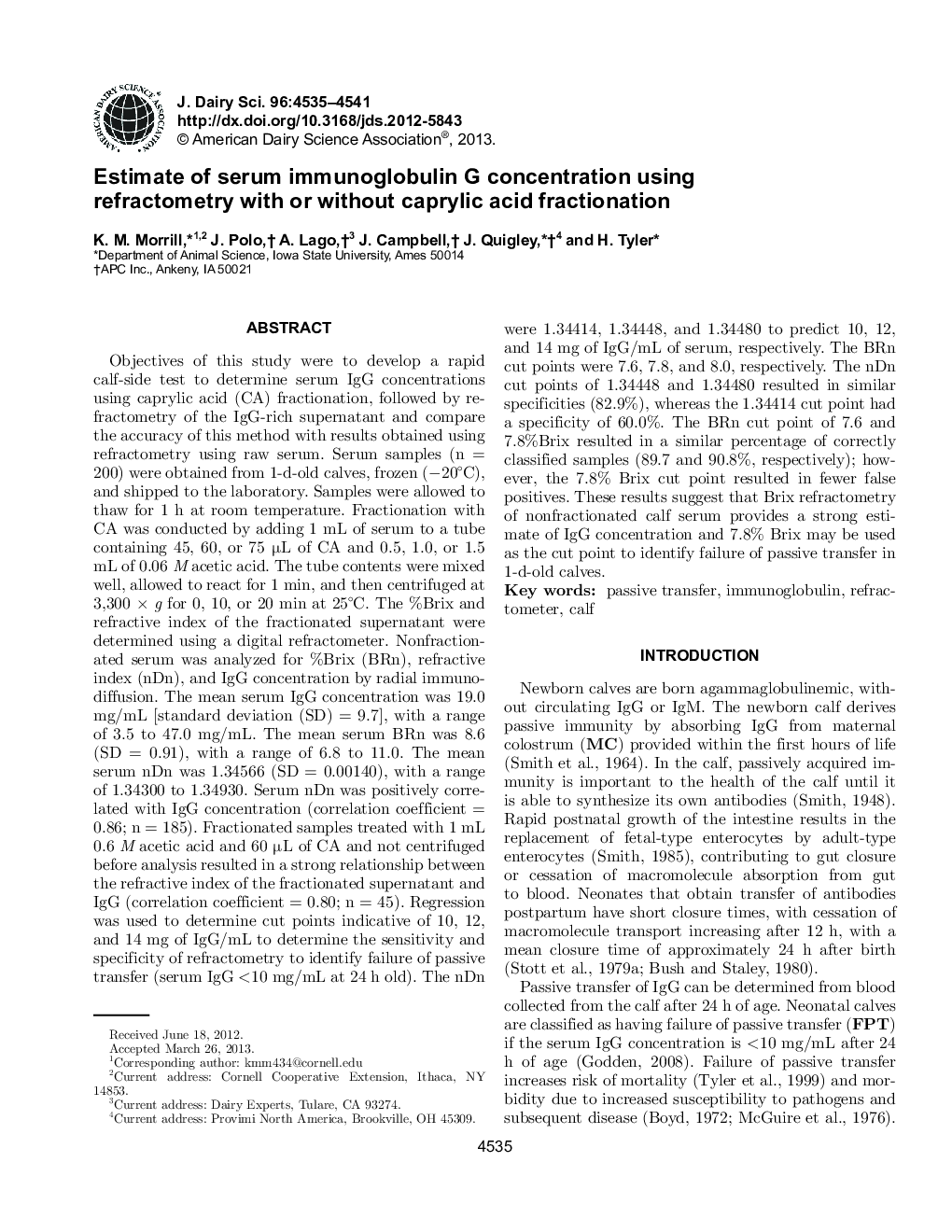| کد مقاله | کد نشریه | سال انتشار | مقاله انگلیسی | نسخه تمام متن |
|---|---|---|---|---|
| 10978016 | 1108054 | 2013 | 7 صفحه PDF | دانلود رایگان |
عنوان انگلیسی مقاله ISI
Estimate of serum immunoglobulin G concentration using refractometry with or without caprylic acid fractionation
دانلود مقاله + سفارش ترجمه
دانلود مقاله ISI انگلیسی
رایگان برای ایرانیان
کلمات کلیدی
موضوعات مرتبط
علوم زیستی و بیوفناوری
علوم کشاورزی و بیولوژیک
علوم دامی و جانورشناسی
پیش نمایش صفحه اول مقاله

چکیده انگلیسی
Objectives of this study were to develop a rapid calf-side test to determine serum IgG concentrations using caprylic acid (CA) fractionation, followed by refractometry of the IgG-rich supernatant and compare the accuracy of this method with results obtained using refractometry using raw serum. Serum samples (n = 200) were obtained from 1-d-old calves, frozen (â20°C), and shipped to the laboratory. Samples were allowed to thaw for 1 h at room temperature. Fractionation with CA was conducted by adding 1 mL of serum to a tube containing 45, 60, or 75 µL of CA and 0.5, 1.0, or 1.5 mL of 0.06 M acetic acid. The tube contents were mixed well, allowed to react for 1 min, and then centrifuged at 3,300 à g for 0, 10, or 20 min at 25°C. The %Brix and refractive index of the fractionated supernatant were determined using a digital refractometer. Nonfractionated serum was analyzed for %Brix (BRn), refractive index (nDn), and IgG concentration by radial immunodiffusion. The mean serum IgG concentration was 19.0 mg/mL [standard deviation (SD) = 9.7], with a range of 3.5 to 47.0 mg/mL. The mean serum BRn was 8.6 (SD = 0.91), with a range of 6.8 to 11.0. The mean serum nDn was 1.34566 (SD = 0.00140), with a range of 1.34300 to 1.34930. Serum nDn was positively correlated with IgG concentration (correlation coefficient = 0.86; n = 185). Fractionated samples treated with 1 mL 0.6 M acetic acid and 60 µL of CA and not centrifuged before analysis resulted in a strong relationship between the refractive index of the fractionated supernatant and IgG (correlation coefficient = 0.80; n = 45). Regression was used to determine cut points indicative of 10, 12, and 14 mg of IgG/mL to determine the sensitivity and specificity of refractometry to identify failure of passive transfer (serum IgG <10 mg/mL at 24 h old). The nDn were 1.34414, 1.34448, and 1.34480 to predict 10, 12, and 14 mg of IgG/mL of serum, respectively. The BRn cut points were 7.6, 7.8, and 8.0, respectively. The nDn cut points of 1.34448 and 1.34480 resulted in similar specificities (82.9%), whereas the 1.34414 cut point had a specificity of 60.0%. The BRn cut point of 7.6 and 7.8%Brix resulted in a similar percentage of correctly classified samples (89.7 and 90.8%, respectively); however, the 7.8% Brix cut point resulted in fewer false positives. These results suggest that Brix refractometry of nonfractionated calf serum provides a strong estimate of IgG concentration and 7.8% Brix may be used as the cut point to identify failure of passive transfer in 1-d-old calves.
ناشر
Database: Elsevier - ScienceDirect (ساینس دایرکت)
Journal: Journal of Dairy Science - Volume 96, Issue 7, July 2013, Pages 4535-4541
Journal: Journal of Dairy Science - Volume 96, Issue 7, July 2013, Pages 4535-4541
نویسندگان
K.M. Morrill, J. Polo, A. Lago, J. Campbell, J. Quigley, H. Tyler,